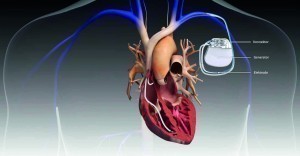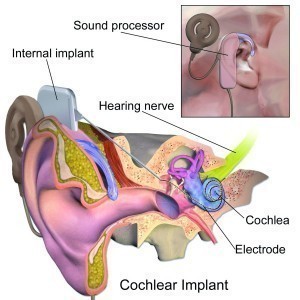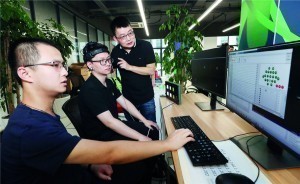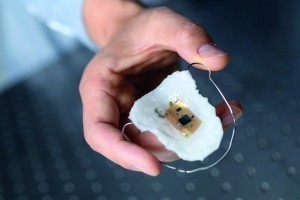While all those who missed the appearance of Neowise will now have to wait 5825 years, Christian children will only have to wait one year at a time for a curved star to reappear - in countless, mostly electrified copies at least, as soon as Christmas comes around. In the electronics industry, on the other hand, innovations pass the baton far more quickly and the growing penetration of electronics into everyday life is often no longer noticeable to the average citizen.
While citizens, politicians and journalists are still up in arms about 5G technology, Google will soon be testing 6G in 17 states (Arizona, California, Colorado, Florida, Georgia, Illinois, Iowa, Kansas, Nebraska, Nevada, New York, North Carolina, Oklahoma, Oregon, Texas, Utah and Virginia) [2]. Of course, all those providers who don't want to fall off the back of the horse have long since come just as far or even further [3]. Too much money is at stake. Fig. 2: Pacemaker implanted in the body (Image: Wikipedia.org)
Fig. 2: Pacemaker implanted in the body (Image: Wikipedia.org)
With the increasing frequencies, communication between the individual devices is becoming more and more efficient, which also has a direct effect on people. The pacemaker is already 'old news', as the first one was implanted in a patient named Arne Larsson in Stockholm in 1958.
 Fig. 3: Cochlear implantEarimplants areless wellknown. Marketed as 'cochlear implants', they have been used several hundred thousand times since around 1980. Instead of amplifying sound, as is the case with normal hearing aids, cochlear implants bypass damaged parts of the ear and stimulate the auditory nerve directly. Signals generated by the implant are sent via this nerve to the brain, which recognizes and processes the signals as sound. However, what is 'heard' still differs from natural sound.
Fig. 3: Cochlear implantEarimplants areless wellknown. Marketed as 'cochlear implants', they have been used several hundred thousand times since around 1980. Instead of amplifying sound, as is the case with normal hearing aids, cochlear implants bypass damaged parts of the ear and stimulate the auditory nerve directly. Signals generated by the implant are sent via this nerve to the brain, which recognizes and processes the signals as sound. However, what is 'heard' still differs from natural sound.
From the ear to the eye: In March 2011, the use of the Argus II was approved in the European Union. This is a bionic eye manufactured by the company 'Second Sight Medical Products'. The Argus retinal prosthesis is an electronic retinal implant and is used as a visual prosthesis to improve the vision of people with severe cases of retinitis pigmentosa.
The number of such and similar prostheses is increasing almost like an avalanche. They are implanted in the body or attached to the skin and, thanks to 5G technology, can now not only exchange data with each other but also transmit it to a central office. Whether this is used to regulate the temperature in the house so that it is most comfortable for the resident or to alert them that their next tablet is due - this shows what possibilities exist. Fig. 4: Principle of Argus II
Fig. 4: Principle of Argus II
It is also the case that as soon as something useful is invented, man immediately thinks about how it can be turned to advantage in murder and destruction: The progress in the military is remarkable, and whether it's drones or new types of firearms, they can't all do without advancements in electronics.
Elon Musk has just announced another advance. With Neuralink, he wants to synchronize our brains with AI, which he took the precaution of demonstrating not on himself, but on some innocent pigs.
The (remote?) goal is to develop a neural implant to synchronize the human brain with AI, allowing the individual to control computers, prosthetic limbs and other machines with thought alone. We can certainly already look forward to the huge field this will open up for the hacker scene.
Self-driving cars no longer even need passengers and soon we will see them meeting up for coffee on the lawn and sipping their cappuccino, which will of course be prepared by robots and served by robot ladies. Electronic sensors for taste are already being developed and should not be withheld from cars. Fig. 5: Networked soldiers
Fig. 5: Networked soldiers
But don't throw the baby out with the bathwater just yet: you can also be secretly amused by the statements of some programmers and overzealous managers who keep pushing ahead and making claims that artificial intelligence models the human brain and thinking ability. This is funny at best, because researchers have not yet decoded the function of our brains and how can you replicate something whose function is not yet understood?
There are even philosophers who believe that our brain cannot understand our brain at all, because a system cannot recognize itself. The discussion about this is constantly generating new models, depending on what is currently fashionable, and entertains many scientists.
However, this should not stop journalists and good marketers from appearing on television with such statements. After all, we have been so 'programmed' by the oversupply of spectacular 'science fiction' films that we are happy to swallow these full-bodied statements unchecked. Fig. 6: Musk's Neuralink - demo initially with a pig (Image ©lightpoet - stock.adobe.com)
Fig. 6: Musk's Neuralink - demo initially with a pig (Image ©lightpoet - stock.adobe.com)
As it turns out, however, Zhejiang University and Zhejiang Lab are cheap, which is fine by Elon Musk. However, this is not about implants and prostheses, but about a new computer architecture that should, for example, enable several collaborating robots to better coordinate their joint actions in emergency situations. This is interesting in the sense that these 'brainlike computers' not only accept keyboard commands as input, but also human brain waves. Whether the communication also works in the other direction is not yet known. Fig. 8: Early September 2020: The brain-like computer in a laboratory in the eastern Chinese province of Zhejiang realizes 'mind typing' (Photo: Xinhua)
Fig. 8: Early September 2020: The brain-like computer in a laboratory in the eastern Chinese province of Zhejiang realizes 'mind typing' (Photo: Xinhua) Fig. 7: This sensor can tell when something is salty (Photo: Rob Felt, Georgia Tech)
Fig. 7: This sensor can tell when something is salty (Photo: Rob Felt, Georgia Tech)
References:
- Wilhelm Hey (1789-1854) composed in 1837 - melodies by Christian Heinrich Rinck and Ernst Anschütz - today usually attributed to Friedrich Silcher (1789-1860). He published the song in 1842 in his song cycle Zwölf Kinderlieder aus dem Anhange des Speckter'schen Fabelbuches
- https://www.techspot.com/news/86415-google-wants-perform-secret-6ghz-tests-17-states.html
- https://www.siliconrepublic.com/comms/huawei-6g-research
Literature:
- E. Waltz: Elon Musk Announces Neuralink Advance Toward Syncing Our Brains With AI, IEEE Spectrum, 28 Aug 2020
- M. Scudellari: Brain Implant Can Say What You're Thinking, IEEE Spectrum, 24 Apr 2019
- https://www.nidcd.nih.gov/health/cochlear-implants
- https://en.wikipedia.org/wiki/Cochlear_implant
- https://en.wikipedia.org/wiki/Argus_retinal_prosthesis
- https://de.wikipedia.org/wiki/Herzschrittmacher
- C.E. Bauer; H.J. Neuhaus: Wearable Electronics & Big Data = High Volume, High Mix SMT!, Proceedings of SMTA International, Rosemont, IL, Sep. 27-Oct. 1, 2015,
- https://en.wikipedia.org/wiki/Holonomic_brain_theory
- http://www.xinhuanet.com/english/2020-09/04/c_139342696.htm
- http://www.xinhuanet.com/english/2019-11/14/c_138553666.htm
 Prof. Rahn
Prof. Rahn
![Every year again [1]](/images/k2/6f7f325422aed3822cba90f577abcf28.jpg)
